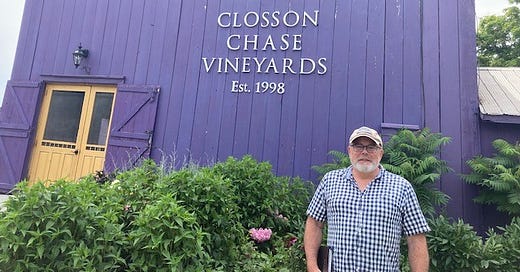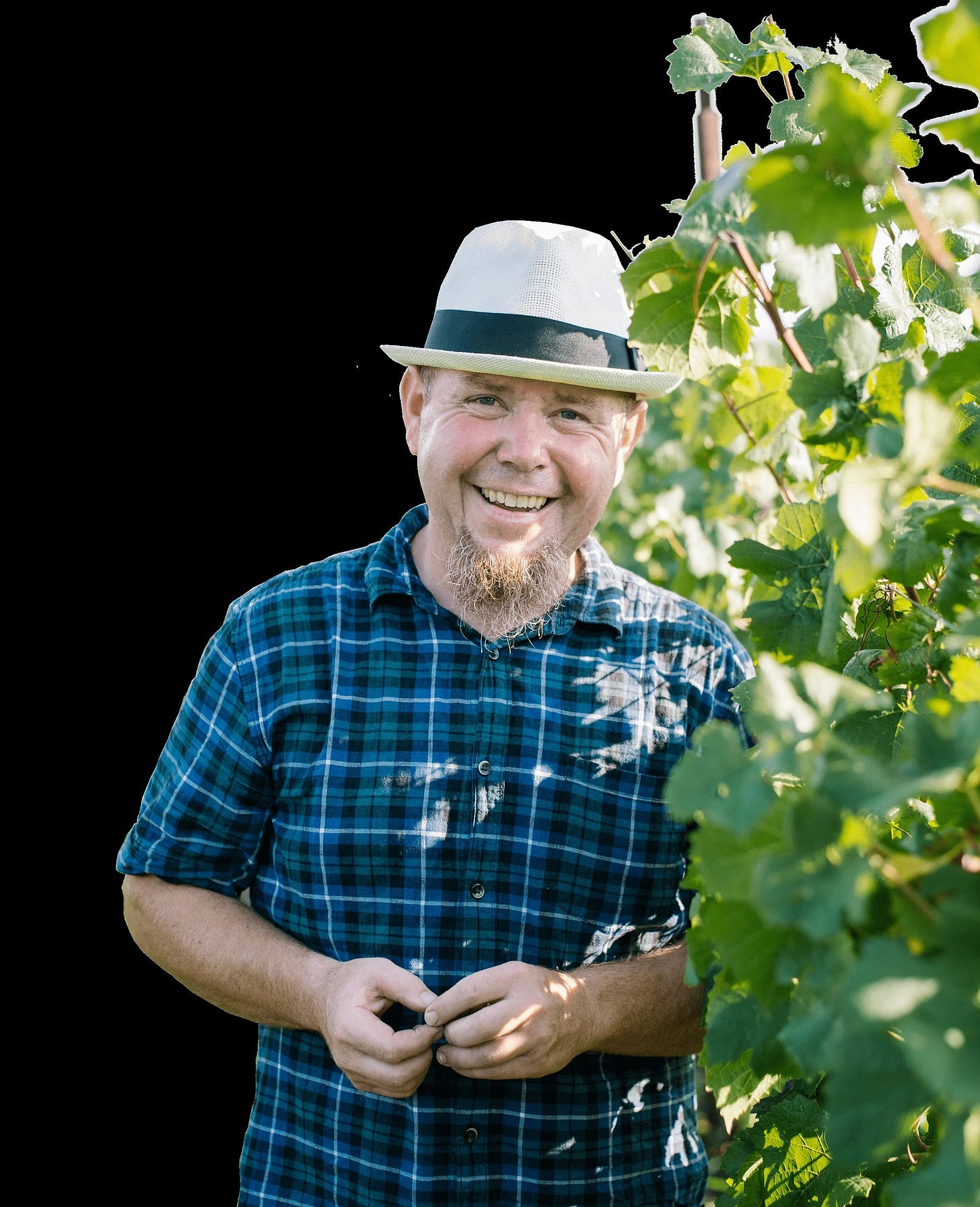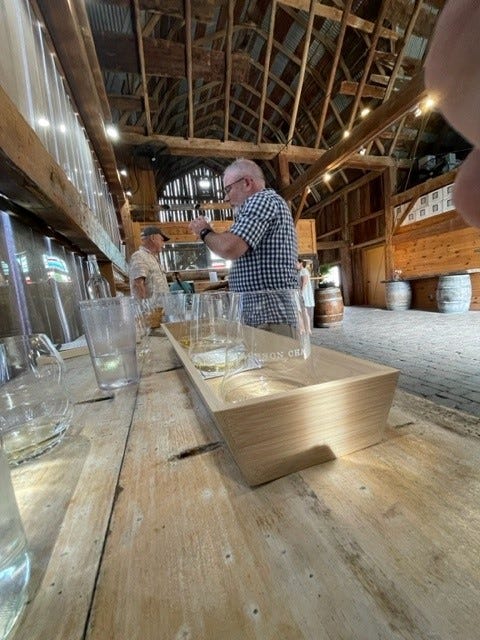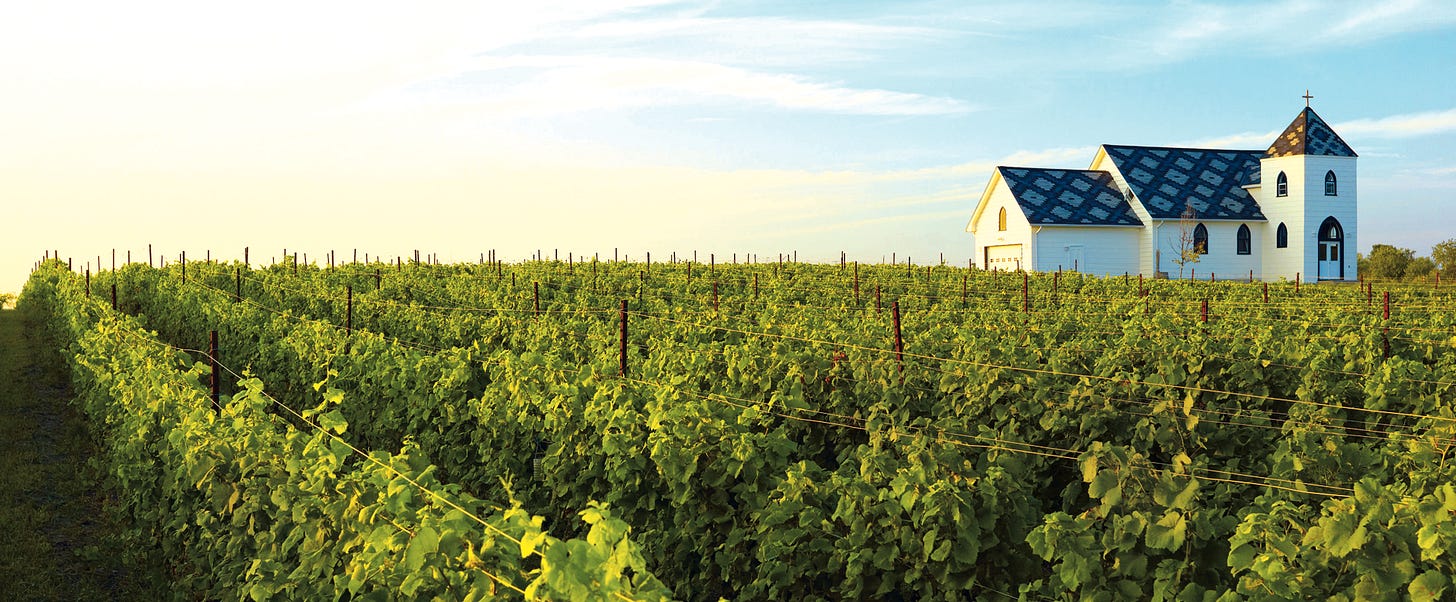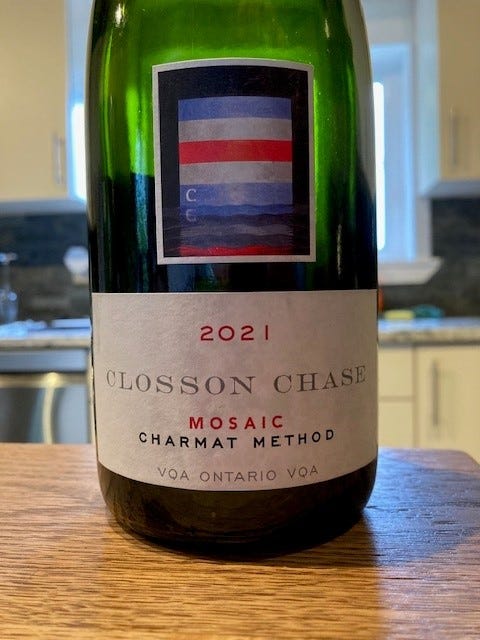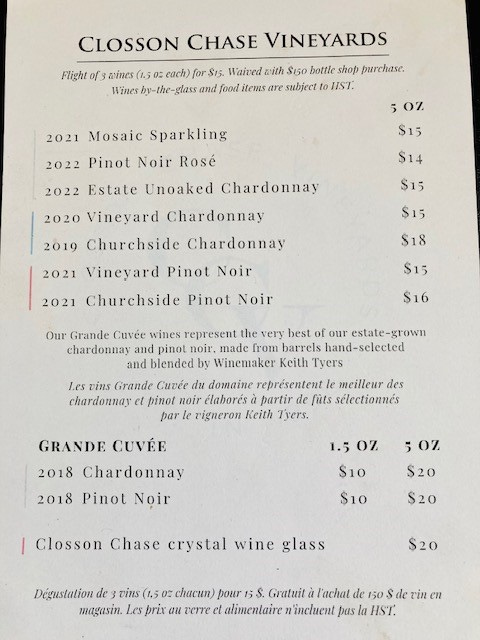You can’t miss the Closson Chase winery from the road because the tasting room is inside a huge purple barn (now a famous landmark in the County), and you cannot forget Closson Chase because it was the most singularly focused winery I visited that day. Indeed, head winemaker Keith Tyers, who took over from founder Deborah Paskus in 2015, makes Chardonnay, Pinot Noir and a bit of Pinot Gris. Period.
It’s hard to miss the huge purple barn!
Closson Chase’s website is fantastic and gives a lot of detail about the winery’s origins and philosophy. I will summarize the winery’s history in 250 words using many of their own words:
Renowned Ontario winemaker Deborah Paskus had a pivotal role in establishing Prince Edward County as a serious viticultural area by establishing Closson Chase, a winery aiming to produce world-class wines in this heretofore unproven wine region. A graduate of the University of Guelph with an honour’s degree in Agriculture (Horticulture major), she embarked on a life-long winemaking journey. She was hired by Moray Tawse, founder of Tawse Estate Winery, as their original winemaker.
After 17 years of experience in the industry, Deborah Paskus believed that Hillier Township in Prince Edward County offered the ideal location for growing Chardonnay and Pinot Noir. After two years of analyzing soils, she fell in love with an old dairy farm owned by early Prince Edward County settlers, the Clossons, finding it a perfect site, and established Closson Chase in 1998. In 2002, they renovated the century-old dairy barn to serve as a tasting bar and processing area–their now-famous Purple Barn tasting room–and the following year Closson Chase had its first harvest.
The winery gained international recognition for its wines at the Seriously Cool Chardonnay Event in London, England, in 2010. Deborah Paskus's innovative viticultural practices earned her the Larry Paterson Award in 2011, recognizing her contributions to the vineyards and her remarkable spirit of innovation in Ontario's wine industry. Her work, including the creation of the famed Temkin-Paskus Chardonnay, played a significant role in shaping the perception of Ontario wines. Deborah retired in 2015 and Keith Tyers took the lead as head winemaker. He continues the focus on showcasing the fruit of the terroir.
Closson Chase head winemaker Keith Tyers: photo from the winery’s website.
The tasting room is simply breathtaking. There is an outdoor patio, but the beauty of the renovated dairy barn put me in a wonderful tasting mood.
The renovated dairy barn makes for an impressive tasting room at Closson Chase
Closson Chase owns several plots such as Churchside, Cold Creek and Ridge. As with the other wineries I visited, they also source fruit from Niagara and show it on the label when it is the case. The renovated church is now also a local landmark in PEC!
The Churchside vineyard at Closson Chase. The original church was built in the 1840s, and was hit by lightening in 1944. It was rebuilt, served as a church until 1969, and eventually was acquired by Closson Chase and moved to this location around 2007. It was renovated to houses vineyard workers! Photo credit: Kyrstin Myers.
My buddy and I first tasted the Mozaic Sparkling Chardonnay, made in steel tank (Charmat method). It was refreshing and surprisingly dry, at only 7 g/lt of residual sugar, and therefore what ‘sweetness’ I detected was ripe fruit. I liked it so much I bought a bottle to enjoy with our wives later that night!
Keith told me he is working on a Traditional Method sparkling, e.g., where the second fermentation occurs in the bottle, where it can age on its lees for a while (the average outside Champagne is 9-15 months). I can’t wait to try this at my next visit!
The 2022 Estate Unoaked Chardonnay was pleasantly surprising with its aromatic green aromas of unripe green apples and grass, along with ripe lemon, with a nice round mouthfeel. All of Keith’s whites undergo malolactic fermentation.
The other Chardonnays have oak programs, ranging from 10% with the 2020 Vineyard Chardonnay, 20% with the 2019 Churchside Chardonnay, with the 2019 Grande Cuvée even being a 5-barrel blend (one of them being new oak) and very powerful, with a pleasant briny taste that comes from the Cold Creek terroir where there is a salty quality to the soil, Keith assured me. This is a HUGE white wine and lovers of lush Cali-type whites would gravitate to this one…unfortunately for me, at $95 a bottle I could not bring one home.
(Note that the winemakers do not have much leeway in pricing their wines, as the LCBO regulates wineries and wine sale prices.)
I tasted four Pinot Noir wines: the 2021 Vineyard; 2021 Churchside; 2020 Cold Creek; and 2018 Grande Cuvée.
For me, the 2021 Vineyard was a bit unripe and tart. That said, the 2021 Churchside was noticeably riper, with a light body and soft tannins. The 2020 Cold Creek PN was vinified in an open tonneau with daily hand pigeage, and showed a wonderful nose and just-ripe red fruit characteristics.
The 2018 Grande Cuvée was very nice and showcases the County’s potential very well. But ringing in at $90 a bottle, one would have to be a devoted PEC wine fan to afford that regularly. That is one of the curses of Canadian wines.
The tasting lineup on July 10th 2023. Flight fee waived with purchases of >$150
To conclude, as you can see from the tasting flight list above, Closson Chase impressed me with its focus on the two Burgundian grapes: Chardonnay and Pinot Noir. I enjoyed his basic unoaked Chardonnay as being honest, authentic, and quite delicious. Keith Tyers is experimenting with a Traditional Method sparking that might prove to be a winner if he can achieve that elusive balance of acidity, just-ripe fruit, and lees ageing. I wish him all the best and hope to visit Closson Chase again.
J-S

